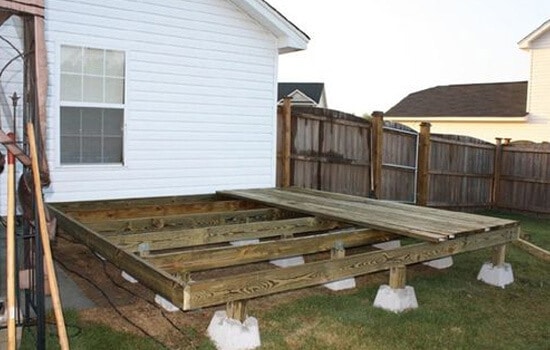We love having an outdoor space in our homes where we can indulge in various activities and make the best out of the expanse.
The floating deck that we usually see in people’s backyards is hosted with the help of deck blocks. But before you start planning a floating deck of your own, think about how many deck blocks do I need according to my home.
Once you have determined the count, you will set foot onto the first step of the ladder of adding a floating deck to your backyard.
The whole process might feel overwhelming with so many questions going on in your mind, but rest assured that by the end of this article, many of your concerns will melt away.
We will guide you through choosing the right size of deck blocks, their significance, what attributes you must consider when buying a deck block, and many other topics that will make the whole task a breeze.

Take one step at a time and let yourself familiarize yourself with new and exciting topics to teach yourself the ABC of laying down a floating deck in your living space.
How Many Deck Blocks Do I Need?
After you have thoroughly inspected the area and are sure that using a deck block will be feasible, let us figure out how many deck blocks do I need? The reference guides of building and construction have a hard and fast rule to determine how many building blocks one needs in their area. There are certain calculations that you can do to find the correct figure.
If you miscalculate and get deck blocks less than what you need, it might be dangerous in the longer run. On the contrary, buying too many will waste precious resources you can utilize elsewhere.
The number of deck blocks you require is in proportion to the weight of your deck and the weight each deck block will be able to support.
The weight of the deck does not necessarily mean the deadweight of the wooden deck alone; rather, the building material used in its construction, the railings, light fixtures, and the weight of people on top of the deck counts in as well. Builders have come up with an average deck weight of 40 pounds for each square foot.
Once you know these figures, all you need to do is divide the total weight of the deck by the average weight a deck block supports. You will get an answer to your question about how many deck blocks do I need?
To make things easier for you to understand, builders have established a base rule that a concrete deck block is needed to support a weight of 4 feet to 6 feet floating deck.
If you consider the live weight of your deck more than usual, you can place a deck block for every 3 feet to 4 feet.
What Are Deck Blocks?
Before diving into this vast topic’s details, we need to get the basic know-how of certain basic concepts.
We must understand what deck blocks actually are and why builders consider them significant in building a project?
Have you ever played with building blocks as a child or seen someone playing with them? These deck blocks are the same building blocks in a grown-up’s building, made of concrete instead of plastic.
These deck blocks snap together and work as a supporting base for the structure above.
The builder will place them onto firm soil as a pre-cast foundation and let them support the deck’s weight. The grooves on the top of these blocks allow wooden beams or posts to be firmly in place.
Types of Deck Blocks
There are various types of deck blocks that builders use to construct floating or elevated decks.
Each of these deck blocks is made of different materials and aims to make installing a deck in your home hassle-free with additional safety features.
Concrete Deck Blocks
Previously, there only used to be concrete deck blocks to support the structure of any floating or elevated decks.
These standard-sized structures were the basic building blocks beneath a deck. The precast concrete deck blocks are easy to use as they come in a ready-to-use state from the supplier.

These concrete deck blocks have been used since long ago without any complaints and provide a sturdy and stable foundation for the above deck.
Line Plastic Deck Blocks
No products found.
When builders thought transporting and carrying concrete blocks to and from the construction site had become a nuisance, they devised an efficient solution.
The line plastic deck blocks are made using high-grade plastic Prone to resist wear and tear caused by organisms under the soil over time.

Line plastic deck blocks replaced those conventional concrete blocks that were heavy to transport and use in installing a floating or elevated deck.
Polyolefin Plastic Deck Blocks
No products found.
Polyolefin plastic is a higher quality plastic than line plastic. This new material is also used to make a highly sturdy and recycled polyolefin material.
The incorporation of ultra-high UV light increases its durability. Engineers have devised a smart solution to all the issues people previously faced when using concrete deck blocks.
The polyolefin plastic deck blocks also have a hole in their bottom that helps with ventilation on the lower side of the deck block.
Improved ventilation means less moisture buildup and lesser growth of insects.

The polyolefin plastic deck blocks provide extra safety and durability for the floating deck positioned above these deck blocks made from polyolefin plastic.
Are Deck Blocks a Safe Option?
Builders have been using the deck blocks in construction for a long time. They are pre-cast concrete foundation blocks, and using those saves the builder time and cost. Now we need to ask ourselves, are they safe to use. As deck blocks are approved in the building codes, however, deck blocks are one of many options like concrete footings or piers we can choose to support the weight of the deck.
We can make deck blocks an appropriately laid solution if their size, weight-bearing capacity, quality of concrete, and spacing between blocks are rightly justified. Builders prefer using deck blocks because they do not decay or rot over time and are a low-cost solution to support free-standing constructions.
Using or Avoiding Deck Blocks
No matter how attractive a deck block seems, one must consider the construction site and understand if using a deck block in the current scenario will be a feasible solution?
In places where the construction above is not complex and will not force the building blocks below to bear more weight than they can sustain, we recommend using deck blocks. For instance, in structures like low floating decks in your backyard.
Builders and architectural experts believe that deck blocks are easier to install in the area where you want to affix a floating or elevated deck.
There is additional merit in having a cheaper price value. The deck blocks require very little preparation, and there is no hassle mixing the concrete mixture from scratch before building the structure.
These deck blocks are more like a ready-to-use out-of-the-box building material. Unlike concrete footing, deck blocks do not need to dig the soil extensively.
Hence the builder or owner experiences a decrease in overall cost. The deck blocks are easy to transport to and from the building site.
On the contrary, we forbid you to use deck blocks where the soil gives away and will not hold the deck block firmly in place.
Take a good look or hire a local inspector to tell you if the soil will frost heave; soil provides less resistance to the deck blocks.
If the climate around your area has strong winds to uplift the wooden structure above, do not use deck blocks.

The concrete deck blocks will sink into the ground if the soil erodes or the builder does not consider distributing the weight of the floating deck evenly over these deck blocks. Proper calculation and planning can prevent such problems from occurring over time.
We insist that these deck blocks be used to construct elevated or floating decks or a shed at a stretch in the corner of your backyard.
Try to avoid using deck blocks in scenarios where the project is directly connected to the house to avoid any damage to the main structure of the house in the longer run.
Spacing and Layout
Laying out the deck blocks with proper spacing under the floating deck enables you to gain maximum strength of the deck block below.
One can layout the design of your deck on a piece of paper or ground before constructing the deck. Then, evenly space the number of deck blocks you have previously determined.
When the builder places the deck blocks at a uniform distance, it ensures that all the live weight of the deck will be distributed evenly across all the blocks.
Less spacing between the deck blocks will lead to a firmer floating deck with promising longevity. Take special care in laying out the actual structure, as careful planning while laying out the foundation of the finished deck will turn over a better-finished project.

Take your time with this step, as it will make or break the aesthetic look of your floating deck.
Preparing the Ground
Begin with leveling the bare ground before you start with anything else. To prepare the soil for installing concrete deck blocks, ensure the ground is on the same level to avoid uneven finished surfaces.
Many builders prefer tilting the surface below at an angle not visible to the naked eye. This action allows easy and quick water flows from the floating deck in case of rain.
One can start with spreading landscape material on the ground to reduce the growth of that creepy crawlies and weeds.
Spread an even layer of sand or fine gravel where you want to build the deck. Experts recommend uniform layers of less than an inch in thickness.
Layering the surface with such building materials before placing the sand blocks will guarantee the longevity and improved stability of the finished structure.
The sand will not erode or get affected by seasonal changes if you layer it with chunky gravel or coarse sand.
The water will gradually disperse during the fall season, preventing the soil from giving away when ice forms below its surface during very cold temperatures.
In some cases, builders prefer pouring treated concrete on the surface where you intend to put up the deck. The benefit of setting the surface with poured concrete prevents the deck from sinking into the ground.
Fix-It up Yourself
Precast deck blocks made of concrete makes your work easier to set up a floating deck on your own. If you want to lay down a set of deck blocks to start affixing your own floating deck, you do not necessarily require a large set of building tools and experience in fixing many floating decks.
One usually does not require a building and construction authorities permit before installing a floating deck at your home. However, we recommend that you must check with your local authorities before getting on with the project.
Fixing up a floating deck with the help of these preset concrete deck blocks is fairly easy. You must clear the area, level the ground where you want to put up the deck, and evenly place these concrete deck blocks over the ground.
Start with fixing the outer frame and finish your job towards the inner of the floating deck. You will have a perfectly put-together floating deck on your own.
Take proper care to follow the instructions in the book and rush through the process. Choose the right wood for your project, and take your time researching what materials will be best for your situation.
Professional Help
some people find the whole idea of installing a floating or elevated deck all by themselves a bit overwhelming.
There is no need to panic in such a situation, and plenty of trained professionals can help you with this tedious task.
Hire the builder with the best reviews and one that gives you the best quotation to cover the construction expenses.
They would know what materials to use and which supplier to approach to get their hands on the best building materials and deck blocks.
The prior knowledge of these professional builders will ensure that you get a floating deck set up with the help of deck blocks at your place, which has a better build quality and smooth finish.
The safety feature of a floating deck set up by a professional will be more promising than the one you do on your own.
Dimensions
Deck blocks come in various sizes and weights according to the manufacturer’s blueprint.

Generally, we see that the deck blocks preferred for use by builders and home architects have a square base of 10 to 11 inches, and their height is 7 to 8 inches. The weight of these deck blocks is around 48 pounds.
These dimensions of deck blocks are designed by keeping in mind the weight of the deck they will support, and the base is wide enough to prevent the deck block from sinking into the ground.
However, suppose your builder decides that these dimensions of deck blocks would not work for your floating or elevated deck. In that case, you can have them custom-made by approaching the manufacturer or distributor.
Price
Deck blocks are easy-to-install features in the foundation of your floating deck. They are readily available everywhere, but before purchasing the deck blocks for your home, ensure that they comply with the building codes and regulations.
In many places, especially in the countryside, deck blocks are prohibited due to the soil being too soft.
These ready-to-use building foundations have a reasonable price, starting from $8 and reaching up to $10 for each block, but this does not incorporate any transportation or installation charges required to fit in these deck blocks.
Deck blocks seem cheaper than other options of this sort, but keep in mind that you have to place these blocks close enough. Hence the overall price is almost the same.
Conclusion
Laying out a floating deck in your backyard is impossible without the fixation of concrete deck blocks.
Using these groovy precast foundations for the structure you intend to install in your home requires research and thinking, such that you come up with a safe and good-looking floating deck.
We hope that by now, you must have determined how many deck blocks do I need. These deck blocks have many attributes that add to their value, with features like ready-to-use, lower price, easy availability, and practicality, making them a preferred building material for countless satisfied customers.



